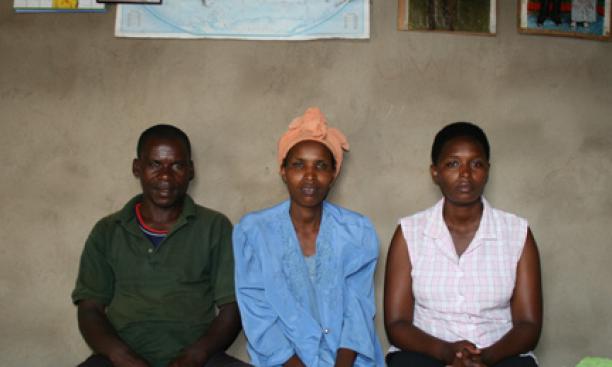
 |
Brittany Urick ’10 interviewed three Rwandans at a reconciliation village. The two women are genocide survivors; the man is a former perpetrator who was permitted to move to this village to live among his former friends and neighbors after finishing a sentence handed down by the country's Gacaca court. (Courtesy Brittany Urick ’10) |
By Brittany Urick ’10
Woodrow Wilson School major and Weekly Blog contributor Brittany Urick ’10 visited Rwanda in August to conduct research for her senior thesis. In the following post, she describes some of what she discovered during her trip.
Bloodstained pillars, pews draped in piles of tattered clothing, and an altar bearing a machete are all that remain to represent the slaughter that occurred in the church at Nyamata in April 1994. Inside, the silence is deafening.
A few miles down the road from the church is a small cluster of cement houses that constitute one of Rwanda's "reconciliation villages," where funding and guidance provided by Prison Fellowship International have made it possible for genocide survivors and perpetrators to live and work alongside one another again.
While visiting a few of the village's residents on the final day of my senior thesis research trip this August, I listened as my translator told me about their peaceful coexistence, their shared farm duties, how their children play together. But amidst the talk of reconciliation, forgiveness, and justice, I couldn't help but notice that the silence that filled the pauses in conversation was marked by fear and mistrust. The words seemed forced, and the silence was more disturbing than that which I had found in the church.
It's undeniable that what President Paul Kagame has done in Rwanda is miraculous. Just 15 years after 800,000 people were slaughtered for being or sympathizing with those on the wrong side of an ethnic divide, a country that tore itself to pieces has infrastructure, investment opportunities, and an unrivaled atmosphere of security. But below the surface, personal and societal healing remain elusive goals, judging from the interactions I had with ordinary Rwandans.
Former enemies living side-by-side has arisen out of necessity; every inch of the land of a thousand hills is inhabited due to its sky-high population density. But physical reunification cannot serve as an indicator of true reconciliation. As long as fear reigns in society, and the processes of healing deep psychological wounds and rebuilding social capital are stunted, reconciliation will likely have to be a generational phenomenon.
